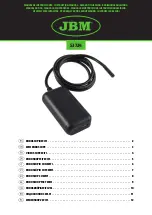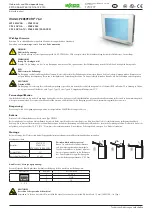
3200 Series Granulators 63”and 84”
357563
•
08/22/2019
24
5-2 Lubrication
The machine is pre-lubricated except for the motor. For motor lubrication, check the tag
supplied by the motor manufacturer.
The rotor bearing lubrication is supplied by an automatic lubrication system. Refer to the
maintenance manual appended to the back of this manual for service information.
5-3 Adjusting the Discharge Air Flow
If the discharge airflow is insufficient, the granulate can accumulate in the discharge
transition just below the screen cradle. The build-up eventually backs up into the cutting
chamber where continued agitation by the rotor can cause overheating and possibly stalling
of the motor.
Do not reach into the discharge cleanout opening with any part of your
body. Movement of the screen cradle at such a time could result in serious
injury.
The discharge damper is located on the end of the discharge transition on the opposite side
from the airveyor outlet. Adjust the damper by turning the counterweight clockwise or
counterclockwise to change the distance from the counterweight to the pivot. Set the
counterweight to obtain the conveying velocity required to move material across the
bottom of the discharge while maintaining maximum air flow through the cutting chamber.
Move the counterweight out, away from the pivot, to decrease the airflow. Move the
counterweight toward the pivot to increase the airflow.
When the discharge chute is pushed back, any material remaining in the discharge transition
may be removed with a shop vacuum.
5-4 Hydraulic Cylinder Inspection
Weekly, check the overall condition of the hydraulic cylinders. If you find problems with the
cylinders or their mounting hardware, do not operate the units. Call for maintenance to
correct the problem. Check the following parts of the hydraulic cylinder:
•
Visually check the cylinders and seals in their extended positions.
•
Check all lines and fittings for leaks of hydraulic fluid.
•
Check the condition and position of the pivot pins at the top and bottom ends of the
hydraulic cylinders.
•
Check that the two nuts at the ends of the pivot pins are tightly locked together.
















































